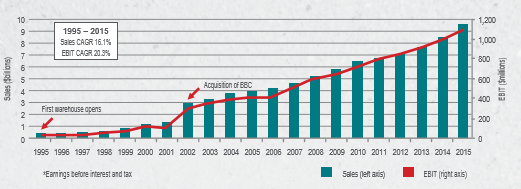Key messages from the 4th Global DIY Summit
In conjunction with The Hardware Journal’s media partnership with the 4th Global DIY Summit, HAI Chief Executive Annemarie Harte attended the two-day event in Stockholm in June and reports on some of the most insightful and relevant presentations.
The summit, which was held on the 8th and 9th June, is the largest conference of retailers and suppliers in the sector, attracting delegates from more than 45 countries and a speaker line-up that includes top industry leaders, innovators, researchers and academics. It was jointly hosted by leading European DIY professional organisations, the European DIY-Retail Association (EDRA) and the European Federation of DIY Manufacturers (FEDIYMA), as well as the global representative of DIY trade interests, the Global Home Improvement Network (GHIN).
The theme for this year’s conference was ‘A Disruptive World – New Trends in Home Improvement’ and there were some interesting interpretations of that title. The digital transformation in retail has forced brands around the world to embrace and adopt websites, social media and, most recently, the mobile web. The ongoing disruption is making retail a hotbed of innovation and an industry in which the most ingenious brands thrive. Furthermore, with the rise of the Internet of Things and Smart Homes, disruptors have also entered our industry. We are also now on the edge of a new era of innovation in home improvement where many companies must transform themselves or they will simply disappear.
Making home improvement accessible for all

The opening day’s keynote from Véronique Laury, CEO of Kingfisher (owner of B&Q and Screwfix) was eagerly anticipated. Both brands have direct impact on the Irish market: one through bricks and mortar, the other through online-only, at this point complemented by heavy multi-media advertising. Unfortunately, delegates didn’t learn about specific plans for B&Q and Screwfix in these islands but Ms Laury shared her thought processes as someone who has worked for Castorama, a subsidiary of Kingfisher, for over 10 years and as a consumer who has gone through the same life-cycle as many of her customers from renting to home owning, from DIY to DIFM (Do It For Me).

Her emphasis was on putting the customer first and living the customer journey. She warned that so much has to be done that isn’t currently being done, and adopting a customer-centric approach is key. She added: “We want to create good homes by making home improvement accessible for everyone.”
Ms Laury noted that, for most people, home improvement is a challenge. Customer journeys are often long and complex, with many barriers and constraints. Based on Kingfisher’s customer research, the company knows that for all home improvement projects, there are seven common steps on the customer journey. Today, she said, retailers only play a relatively small part in their customers’ journeys, largely at the ‘purchase’ stage. Kingfisher’s aim is to better service customers throughout all stages, which will ultimately lead to more satisfied customers and encourage more people to do more home improvement projects (see Figure 1).

The way Kingfisher will go about delivering that customer journey is through:
1 Changing mindset
Ms Laury gave a simple example of how employees are not empowered to make decisions on the shop floor – on some returned goods, for instance, they have to seek a manager’s authority. Giving clear guidance to employees and enough flexibility to enhance this process will surely result in a better customer experience, she suggested.
2 Changing the organisation
Having one vision for the organisation – the ‘One Kingfisher’ plan – is a major objective. Appointing a Chief Customer Officer and getting the balance right between rational and emotional intelligence at management level will drive this change, she believes, as will investing in people and leveraging scale.
3 Changing the way it measures and rewards performance
Identifying the profitable transaction is a vital step and winning the battle of advocacy for employees and customers is also crucial.
4 Changing the way it looks at customers
Understanding the customer’s budget and putting home improvers at the centre of the process while understanding their relationships with ‘helpers’ who assist in getting home improvement jobs done, including friends, family and tradesmen.
5 Changing the way it interacts with customers
Growing customer capability and embarking on home visits to listen to customers. She concluded: “One thing will not change and that is being purpose-led. Speed, however, is of the essence because the world is changing so quickly.”
Subsequent to the Summit in Stockholm, B&Q opened their first new ‘big box’ format at their Cribbs Causeway store in Bristol in mid-June following six months of work which took place while the store remained open. It now offers customers over 40,000 products including 2,500 new and exclusive products with lighting, paint, home décor, tiling, bathrooms and kitchens among the areas heavily invested in. Together with highly visual and informative displays, the new format ensures that customers are better able to ‘do-it-themselves’.
Be a disrupter, not disrupted
John Gillam, the Managing Director of Bunnings, was of particular interest, as Bunnings is the new owner of Homebase, which it bought in February. Homebase reported revenue of £1,461.2 million for the 12 months ended 29th August, 2015 and currently has 263 stores. Mr Gillam’s presentation was titled ‘Leadership Matters’ and even though it was a relatively short speech (25 minutes), it was also one of the most relevant, given the direct competitive relationship between Homebase and hardware stores and builders merchants here in Ireland.

Mr Gillam, a no-nonsense, straight-talker from Down Under, began with the advice: “Be a disruptor and not disrupted.” He said that Bunnings cares for its team, its customers, its community and its suppliers. Bunnings invests in staff development through:
• product and project knowledge;
• profit-share and ownership;
• invests in keeping them together (retention levels are currently 89%).
Of their 40,000 team members across Australia and New Zealand, 62% own shares with 340 team members involved in study tours, management development and future leader programmes in 2015. While it was an impressive on-stage performance, one wonders if the emphasis on overt ‘caring and sharing’ would work in the traditionally more cynical UK and Irish mindset?
The company’s plan for 2017 involves: creating better experiences; strengthening its core operations; driving stronger growth through a stronger team; better stock flow; improved productivity; and deeper community involvement. Bunnings’ digital brand reach involves serving customers everywhere and, in its digital strategy it significantly differentiates its offering and mitigates the threat of online-only brands. The company calls it a ‘digital ecosystem’ which is based on all-encompassing engagement with customers. He said that Bunnings is matching the most sophisticated shopper experience in 2016 and proudly boasts to be the fifth most visited retail website in Australia, with only the likes of Amazon and eBay ahead of it in the DIY/Home Improvement space. Impressive, although a quick search for their Twitter handle, (Twitter being, of course, a core customer service tool for business) revealed the last update was on 2nd February, 2012 and that was to refer customers to its website, despite the fact that it has 2,721 followers.
Turning to the UK and Ireland, Mr Gillam explained that the company’s plan would be delivered in three phases:
1 building strong business foundations in the first 12 months;
2 introducing a new Bunnings-branded offer within three to five years; and,
3 driving long-term growth beyond the initial five years.
Bunnings has already hit a road block in the UK as it is going to have to live without its famous slogan “Lowest prices are just the beginning” after the UK Intellectual Property Office (IPO) refused the company’s application to register its strapline for use in the UK. This strapline, as well as its “Lowest prices everyday” slogan were both refused by the IPO, due to the slogans being classed as “too general.” Bunnings will now have to find another slogan to represent its everyday low-price offer and to differentiate it from B&Q. Gillam still left us with some food for thought: “It’s got nothing to do with size, just about being better.” Will the recipe for success from Down Under work as well Up Here? Watch this space!











